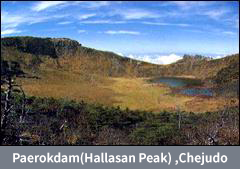CAC CONTENTS
-

-
CAC Contents
-
A great volcaic upheaval
- Outline
- Mountaineering around the capital
- Mt. Sorak with fascinating sights
- A great volcaic upheaval
- Scaling of high mountains aborad
- Overseas expeditions by CAC & KAF
- Vigorous climbing movement in Korea
- New Start
- Korean Rock by Rick Ruffin
- Seoul Big Slab by Rick Ruffin
- Winter Trill in Korea by Cho sung dae
A great volcaic upheaval
A great volcaic upheaval
-

-
Cheju Island, the largest island of Korea, is an extinct volcanic cone about 150km away from the S coast of the peninsula.
The summit of this conical island is Mt. Halla (1950m), which is, together with the island itself, abundant with myths, legends and folklore passed down to the population of 300,000. Contrary to the mainland, the island enjoys and oceanic climate. Until mid-60s the passage to this place was quite an enterprise but now airlines and speedboat services are plentiful.
IRoads on the island have been paves and approaches to Mt. Halla are easy to track, thus making the ascent to the summit and back a matter of one day.
The ascent to the summit of Mt. Halla (which is an accumulation of great volcanic upheavals) begins with choosing either of the 2 traversing paved highways running along either E or W of the sweeping piedmont. There are 5 varied routes of 6-12km toward the summit but the present writer would introduce the mountain by following the shortest course (6.8km) on the SW slope.
In 20 minutes by an automobile from Cheju City one can reach Ipsung Pavilion ( a cottage inn, 1200m) at the entrance of the main course. On the way up to the 550m levels, low trees and meadowy grass cover the rocky terrain with mild undulations sloping up to the central rise. This low part of the piedmont has provided ranches for cattle and hunting grounds for the upper updated these areas with new ranches of cattle, horse, sheep, hogs and deer, together with well-cared-for hunting fields and golf links.
Above this level are thick woods noted for their various characteristic species of vegetation. Toward Sogwipo City on the S hem of the island are tangerine and pineapple farms of subtropical nature, but the piedmont has plants of the temperate zone, while the upper slopes are rich with flora of the frigid zone. There are more than 1700 species of plants on Cheju Island comprising about 50% of all kinds discovered on the Korean peninsula. More than 200 are indigenous species of Korea and there are about 100 kinds found only on Cheju Island IUCN has conducted several studies and scientists and scholars all over the world are showing much interest in this island.
From Ipsung Pavilion after about 40 minutes of forests there is a rocky belt where numberless columnar masses of lava in changeful shapes more than 100m in size pose on a rocky surface. Ancient poets called these rocks the 500 disciples of Buddha. This rock pattern is witnessed only here and on the summit alone. About 360 cones of parasitic volcanoes, large and small, and many natural tunnels thereof are found scattered on the whole island to modulate the rather monotonous repetition of simple shoreline and skylines.
The crater on the summit is a surprise to the climbers' eyes with its 1km circumference and 50-100m of depth. The legendary Baeknokdam Lake lies quiet on the bottom. Not only the colorful brocade mingling the red, white, black, brown hues of the volcanic soil and rocks with the green, yellow and other tints of high-altitude plants but also the grand panorama spreading from the outer walls of the crater to the shorerims of the entire island is an eternally unique and moving experience.
For mountaineering on rocks, ice and snows, Korean climbers periodically try his summit as if on a pilgrimage.
The attempt can, with a combination of different approaches, be a small-scale exploration with stages of sea voyage, forest venture and weather seasoning plus hard alpinism.
The rocks and the rocky surfaces of S and W rising to the summit are not long enough to present difficulty, but the fragile volcanic rocks in an inclement weather of strong winds, rains and snow can offer challenging conditions to hard trainers.
For this reason, more routes are expected to be discovered in future though there are already several existing routes of Grade III to V. When the mountain is covered by one of the thickest snows in S Korea, 2 to 3m deep, the whole vast slopes are brilliant with pure whiteness accentuated by tree-icicles.
Also, E and N routes of 9-12km become superb ski runs over the greater length of the courses. However, the stormy weather characteristic of Cheju Island beats down for days in succession sometime during winter and there have been occasional mountaineering accidents of minor significance here


 ENGLISH
ENGLISH


